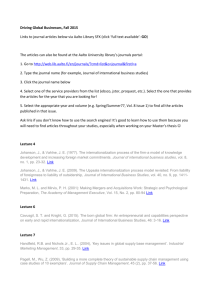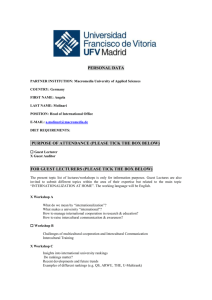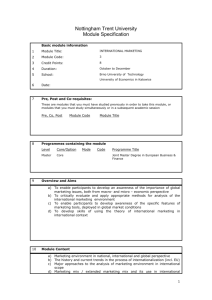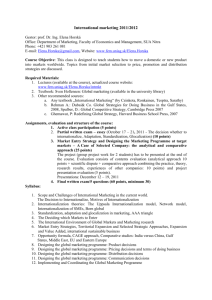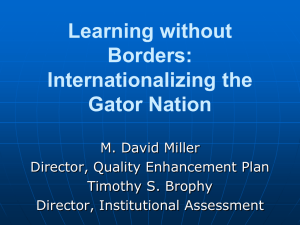internationalization of information infrastructures and control
advertisement
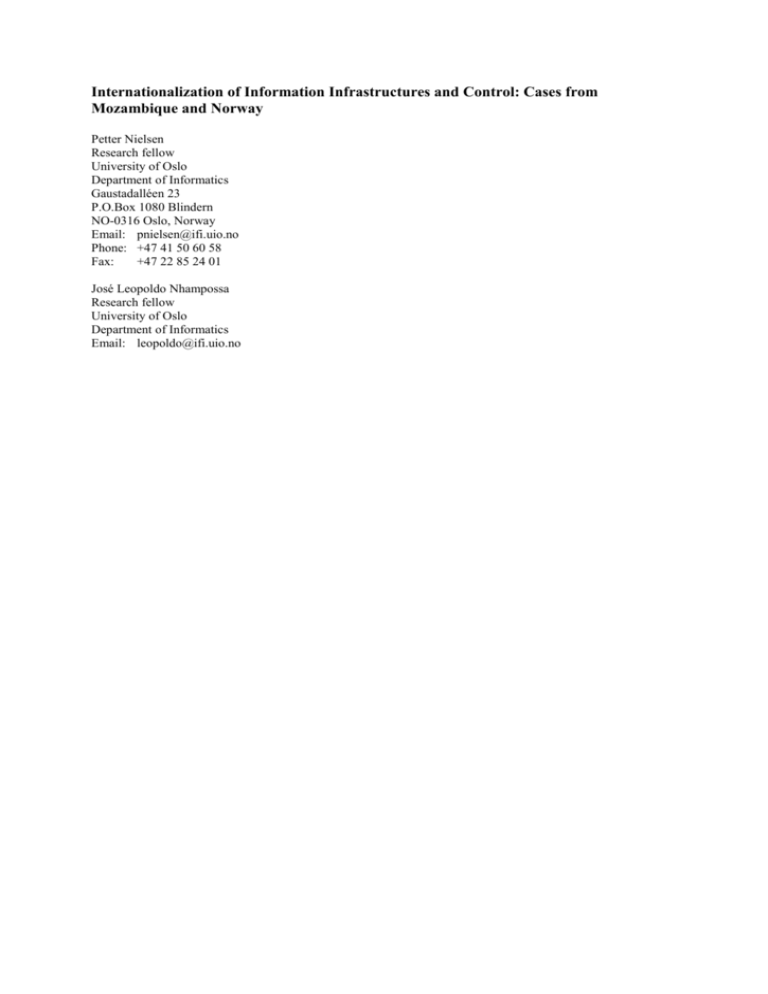
Internationalization of Information Infrastructures and Control: Cases from Mozambique and Norway Petter Nielsen Research fellow University of Oslo Department of Informatics Gaustadalléen 23 P.O.Box 1080 Blindern NO-0316 Oslo, Norway Email: pnielsen@ifi.uio.no Phone: +47 41 50 60 58 Fax: +47 22 85 24 01 José Leopoldo Nhampossa Research fellow University of Oslo Department of Informatics Email: leopoldo@ifi.uio.no ABSTRACT Based on the growing interest in internationalization in the information systems (IS) domain, this paper examines two attempts of internationalization. The first relates to a health information system for developing countries and the second concerns a telecommunication platform for premium rated SMS services. Discussing the experiences from these cases we use concepts from information infrastructure (II) as our theoretical and analytical lens. This analysis leads us to the articulation of an extended framework for theorizing and understanding the processes of internationalization. Our discussion engages with the inherent challenges of internationalizing IS, in particular the tensions related to control. Throughout the paper we will show that internationalization processes are highly contingent upon the IIs it is growing out from and into. The discussion will in particular concern the nature of standards and relations between the global and the local as well as the choice of a process or a product approach towards internationalization. Keywords: Internationalization, information infrastructure, control, flexibility, context sensitivity, standardisation, Mozambique, Norway 1. INTRODUCTION In this paper we discuss internationalization of information systems (IS) as a process with the aim to support the reuse of technical and human resources and building and sharing of knowledge across national borders. Accordingly, internationalization is pursued with the aim to reduce the costs of developing as well as implementing an IS as compared with starting from scratch in a new national context. Very much in line with current globalization processes, system development organizations are working to get and support the access to larger and possibly global markets. At the same time, new constellations of organizations such as multi-nationals are increasingly seeking to pursue international synergies on their disparate, scattered and disintegrated IS investments (Buss 1982). Internationalization is however a challenging endeavor, not only when linking developing and developed countries (for example Odedra-Straub 1992), but also within these different worlds. The software design discipline has for decades discussed and appropriated the need for flexibility and compatibility. Decomposition and modularization, or loose coupling and close cohesion (e.g. Yourdon and Constantine 1979) have been identified as approaches to cope with the complex software systems. Based on these insights, researchers have engaged in providing adequate support for internationalization of software systems (for example Coronado and Livermore 2001; O'Donnell 1994; Russo and Boor 1993). Internationalization is understood as developing software systems to support localization, and ensuring their smooth adaptation in a specific national locale, for example to its different language, standards, legal requirements and cultural norms. Management and development of international information systems (IIS) as a product have been discussed by organizational sciences as challenging for multinational corporations and their executives. Research in the IS field has addressed the variety of challenges related to standardization of inter- and intra-organizational IS in the strive towards universality and in particular to strengthen centralized control in global organizations (for example Ciborra et al. 2000; Ives and Jarvenpaa 1991; Rolland and Monteiro 2002). Drawing upon the lessons from software design, these studies have in particular illustrated how control over large scale systems can be challenged by lack of modularization and in particular local variations in system implementations and work practices. Applying a socio-technical perspective, these studies have illustrated that control is in tension with flexibility, and that managing this balance is also related to issues such as diffusion of standards (Hanseth et al. 1996) and the inevitability of situated work practices (Ellingsen and Monteiro 2003). However, little attention has been given to internationalization as a process as well as to the unique contextual issues such as existing and available technologies, human resources and work practices where the IIS is to be localized and implemented. The research reported here is based on two case studies of internationalization initiatives. The first case is related to a health information system, the District Health Information System (DHIS), developed in South Africa and its process of internationalization and implementation in Mozambique. The second case concerns a telecommunication platform for premium rated SMS services, the Content Provider Access (CPA) platform, developed in Norway and its process of internationalization and implementation in countries such as Denmark, Malaysia, Hungary, Ukraine, Thailand and Bangladesh. These cases are dissimilar in context, conditions, content and results. However, both cases represent initiatives with the same aim of internationalizing ISs, and thus allow us to get some relevant insights in the related processes and approaches. While we relate our discussions to the referred studies concerning standardization in the IS field, the ISs discussed here are by nature nationally fragmented and independent and the challenges of control are thus not related to attaining and sustaining organization-wide and centralized control. We primarily discuss control as the challenge of on the one hand implementing and preserving global standards and on the other implementing standards locally in a context sensitive manner. The primary aim of this paper is to contribute with new conceptual insights in the challenges of internationalization processes and specially related to issues of control. Our primary research question is how internationalization relates to the context which it is growing out from and into. We will more particular focus on how approaches vary between internationalization of products and processes as well as how control in internationalization is pursued through standards and relations. Focusing on the balance between the local and global challenges related to universal solutions (Bowker and Star 1999; Rolland and Monteiro 2002), we engage in the discussion of the different facets of control. The rest of this paper is organized as follows. In the following section we briefly discuss the theoretical basis followed by the introduction of the two case studies in section 3. Section 4 provides an analysis and discussion of the cases based on the theoretical perspective. Finally, in section 5 we conclude by drawing some theoretical as well as practical implications. 2. THEORETICAL BASIS: INFORMATION INFRASTRUCTURES In this paper, we discuss internationalization with an II perspective, understanding the ISs as intrinsically composed of, interdependent and interconnected with collections of socio-technical components (e.g. Hanseth 2000; Hanseth and Monteiro 1997; Hanseth et al. 1996; Star and Ruhleder 1996). IIs are thus not relatively simple, standalone and self-contained systems, but rather represent large and open socio-technical networks of heterogeneous actors. These actors have different perspectives on and only partially control over the II (Neumann and Star 1996; Star and Ruhleder 1996). This perspective provides us with the means to study internationalization as a process framed within socio-technical networks. As we move beyond issues of centralized management and technical software engineering, this perspective help us recognize internationalization processes as necessarily both related to product and process and means of control spanning from standards to relations. As internationalization necessarily involves several of these networks, i.e. the network where the IIS was initially developed and grows out from and the various local networks which it is growing into, internationalization processes are intrinsically complex as any centralized efforts of control only effects parts of the networks. It is thus highly challenging, yet essential to overcome the tensions with past infrastructures, procedures and practices (Timmermans and Berg 1997) by not being “installed base hostile” (Hanseth et al. 1996). Internationalization is therefore a process of cultivating the installed bases of the involved IIs. At the same time, the nature of these installed bases is highly influential in shaping the possibilities of control in internationalization processes on the global as well as the local level. Standardization serves both as a mechanism for control and also introduces tension between the global and the local (for example Hanseth and Braa 2000; Rolland and Monteiro 2002). In internationalization, lack of standardization in local implementations will render impossible scalable control and further sustainable reuse. At the same time, the simplicity and efficiency of an internationally uniform solution from a global perspective can easily become suboptimal locally (Damsgaard and Truex 2000). However, control can also be attained and maintained through formal or informal relations between the global and the local actors. Based on the available means of control, this choice between global and locally optimal solutions in the relationship between IIS and its local implementations (LocalIS) must in any case be balanced, what Rolland and Monteiro describe as the “pragmatic balance”. 3. CASE DESCRIPTIONS The empirical materials we draw upon here originate from two independent case studies conducted by the authors respectively. The first case is based on an in-depth study of the development and the current operation of a platform for premium rated SMS services for mobile phones (the CPA platform) in Norway and related internationalization attempts. During 2003 and 2004, 39 semi-structured interviews where conducted with a variety of actors related to the CPA platform. While some interviews were conducted among Norwegian actors only involved with the implementation of the platform in Norway, other interviews concerned employees occupied with the internationalization process pursued by MobiNor, as well as those working with the implementation of the CPA platform in the affiliates of MobiNor in Denmark, Malaysia, Hungary, Ukraine, Thailand and Bangladesh. The second case study was conducted from 2000 to 2003 as part of an action research effort in a global research and development program known as Health Information System Project (HISP) (Braa et al. 2001). The fieldwork included working within a multidisciplinary team in Mozambique and making two visits to South Africa to interact with the software development team as well as attending a locally organized summer school. 3.1. Internationalizing a platform for premium rated SMS services In 1999, the mobile phone network operators in Norway launched their CPA platform, enabling premium rated SMS services. The technical CPA platform builds on a business model which enables content providers to sell content directly to mobile phone subscribers through the mobile phone network, by the network operators allowing for premium rated SMS messages, i.e. enabling content providers to charge subscribers for more than the cost of regular peer-to-peer SMS services. Based on the two different network operators coordinating common short codes, price classes as well as a common service level, ease of access as well as a transparent market for the content was created. The operators did thus not choose to compete on differentiation with services exclusive provided in one of the networks, but on the contrary pursued an “open garden” approach. Branded and advertised by the content providers, the content becomes easy to use as any subscriber can order the content from the same short code for the same price. The typical content sold through the CPA platform comprises mobile phone ringtones and screensavers, jokes, Java games, news information, traffic information, weather information and phone directory services. Content acquisition by subscribers is simply based on mobile phone subscribers requesting content by sending an SMS (Short Message Service) (figure 1) message. The SMS is processed by the SMS-centre (SMSC) of the network operator and forwarded to the content provider by the CPA platform. Upon request, the content provider returns the content by the CPA platform, and accordingly the cost which the subscriber is to be billed is specified with a rating class. Based on this, a billing request is sent by CPA to the billing system of the operator. The revenue generated is shared between the network operator and the content provider as per an agreed revenuesharing model. Subscriber Network operator SMSC operator Network SMSC CPA 2 and 6 CPA Content provider Billing system Billing system Figure 1 The basic components of the CPA platforms The technical implementation of the CPA platform by one of the network operators, MobiNor, was based on a bottom-up initiative taken by a few key employees and drew upon relatively few resources. Only these employees really believed then in the underlying idea. Since MobiNor did not allow for an “open garden” approach, the implementation did not only lack management support but also violated the business and competitive strategies. However, coordination with employees from the other network operator as well as potential content providers quickly led to a successful platform and market for premium rated SMS services. The key challenge during this period was to create and maintain coordination between these actors as well as to develop a common appreciation of the platform. The platform implemented by MobiNor was technically an extension of an already existing facility for providing content services which was integrated with the billing system and the SMSC. The old platform, however, did not provide open access for content providers as well as a business model only providing exclusive content for MobiNor subscribers. As the result of the continuous process of identifying interesting concepts for internationalization, CPA was in 2001 identified by the international division of MobiNor as an appealing platform for implementation in its various globally dispersed affiliates. This was only one project among others dealt with by this synergy area, and close related to the process of turning from a financial investor to an industrial investor towards the affiliates. Representatives of MobiNor traveled the affiliates’ locations to introduce the platform and a related business case, as well as to provide consultancy services where required. This process was not based on internationalizing CPA as a software platform, at least partly as a result of recent failed attempts of internationalizing similar platforms. On the contrary, a “sharing of best practices” approach was adopted. Following this approach, personnel from Norway interacted with affiliates based on their knowledge of the platform’s operations in the Norwegian context. This best practice has since been formalized as ”12 guidelines for best practice”, describing the need for an “open garden” approach, a symbiotic relationship between network operators and content providers as well as the ease of its use. Affiliates situated in Bangladesh, Denmark, Hungary, Malaysia, Russia, Sweden, Thailand and Ukraine had implemented the platform by 2004. These affiliates have their own history and have adopted locally suitable approaches to provide premium rated SMS services while taking into account the national contexts, such as the maturity of the telecommunication market, the relationship among network operators and between network operators and content providers as well as the concerned regulatory regimes. These locally inspired (and, therefore different) implementations of CPA, reflects varying degrees of success. These differences are exemplified in the following examples. Most affiliates offer mobile originating billing (MT-billing), i.e. billing the subscriber on the receipt of the content as shown in figure 1. Some of the network operators do, however, consider it more appropriate to base their billing on the subscribers’ request of content (MO-billing). Technically, the former is enables different models of billing, such as subscriptions to daily weather forecasts or receiving alerts when stock prices cross a certain threshold. MO-billing, on the other hand, renders it impossible to rate requests sent to the same number differently. This limits the flexibility available to content providers and adversely impacts ease of acquisition, thereby attenuating the potential for CPA’s success envisioned in the guidelines. Some sort of proactiveness from the network operators towards the content providers and an entrepreneurshipspirited approach by the latter are required to create a prosperous CPA market. Companies based in countries where content providers were not flourishing suffered from lack of content services and a weak market, such as in Thailand and Hungary. This was in sharp contrast to the situation prevailing in other markets, where a range of small entrepreneur spirited content providers were active in the market, both before and after the CPA business model was introduced, e.g. in Malaysia. The maturity of the telecommunication market related to CPA is in particular dependent on the relationship between the network operators. In some of the markets where the network operators have had a long and fruitful history of cooperation (as in the case of Norway), while in some others, a “walled gardens” approach has been further exacerbated by strong mistrust among them. In one affiliate, cooperation among network operators was spurred by the content providers in context of the CPA, but no agreements to create a permanent open standard could be reached. In addition, the absence of informal interaction between the network operators thwarts coordination efforts. The local implementations of CPA appear differently and have shown a highly varying degree of success. With an approach to internationalize on the level of best practices, and understanding CPA as closely linked to the variety of local IIs, this do not come as a surprise. The key aspects of the internationalization process are summarized in table 1. Table 1 Key aspects of the CPA internationalization process Platform based on bottom-up initiative, coordination among network operators and between network operators and content providers. MobiNor not in control in Norway, and affiliates not in control locally No-standardized product, only visiting consultants from MobiNor. Non-standardized process in different in local contexts, and guidelines only describing “best practice” in Norway The local implementations (as well as the original CPA platform) are thus highly dependent on the installed base of e.g. cooperation among operators and their proactiveness towards content providers as well as the existing billing systems and SMSCs. 3.2. Internationalizing a district health information system for developing countries Initiated under the Health Information System Project (HISP), the district level computer-based health information system (DHIS) for processing of data received from Primary Health Units (PHU) was accepted as a national standard in South Africa in 1997. Together with an underlying open source philosophy driven by the overall goal to achieve equity in health, a participatory and bottom-up approach was seen as essential in its development (Braa and Hedberg 2000). Over the years, the DHIS has been regularly updated and its functionalities improved as per emerging management/community needs. Later versions have also taken advantage of the ongoing developments in hardware and software technologies, for example by way of designing more effective visual interfaces, incorporation of query-based reporting etc. The DHIS combines both routine data from the health services and semi-permanent data on the health facilities like number of beds, equipment, staff, budget, population, etc. These types of data (also called denominator data) are linked to the indicators engine which allows defining and calculating indicators on any combination of data elements using the numerator/denominator framework. An important activity in the implementation of DHIS in South Africa was to identify the essential dataset (EDS) to provide an effective template for data collection by PHUs. The composition of EDS was finalized through a participatory process of consultations involving policy makers, health workers, computer system designers and communities. Acceptance of EDS by these stakeholders eliminated earlier redundancies in data collection, pinned down responsibility for collection and update of data elements, while also providing an unambiguous framework to generate various reports at frequencies and formats desired by managers and other users. In 1999, the HISP initiative was taken up in Mozambique. Based on it successful implementation in South Africa, as well as it emphasis on decentralization and participatory design, its strategies, processes and tools such as DHIS was transferred. Even if based on a success story from South Africa, the need for a deep understanding of the context including the health structures and information processes was identified. Priority was given to creating local teams and enrolling researchers and practitioners to undertake the localization process with central support from South Africa. The responsibility of the HISP team in South Africa is thus both to serve the local implementations of DHIS as well as to support a broader network. Since DHIS is based on open source, the users had full access to the source code, and could introduce changes according to their needs and local conditions. They were also allowed to freely revise the source code as well as redistribute it (Braa and Hedberg 2000; Braa and Hedberg 2002). DHIS was initially not internationalized before its transfer to and piloting in Mozambique, simply because it was not originally meant to be used in contexts other than South Africa. The initial releases were thus designed and implemented to meet the language, format, culture and regulation requirements of South Africa. The change of strategy to also include internationalization suggested that the piloting now should involve support for localization, including changes related to e.g. creating a modularized and three tier architecture of user interface, functionality and database as well as adding new modules or other features. Several localization challenges were experienced, for example, the structure of the database reflecting the five levels of units in the South African health systems had to be changed to accommodate for the four levels in Mozambique. Other aspects related to language (Portuguese), naming conventions, hierarchical structure and levels also needed to be defined as starting point, at the level of the database, the user interface and the reports. The adaptation of DHIS in Mozambique does not follow a remove-replace but rather an add-on strategy whereby e.g. new language support was added without modifying the original software. Since technical support was absent in Mozambique, all changes to the software were sent to South Africa for the manufacture of a setup CD. New CDs from South Africa acted as a new release with newly added features and bugs fixed. The testing of the new release was conducted in the piloting sites, and further changes required were sent back to the main hub in South Africa, where the setup CD was again manufactured and subsequently sent back to Mozambique for testing and use. The multiple adapted release cycles of the DHIS software suggested an endless process of interaction (with South Africa), whereby the integration of the new releases implied starting more or less from scratch. The new initiatives and features locally implemented in Mozambique are at the same time not necessarily relevant and even compatible to the new releases generated for internal use in South Africa. At the same time, however, the initiatives taken up have contributed to the global DHIS software. Although at a conceptual level the continuous release cycles with South Africa could be discarded in the favor of an autonomous approach, in practical terms such procedure was not feasible in Mozambique. The nature of interaction between Mozambique and South Africa, emphasizing collaboration and sharing of experiences have up until now developed a stable and mutually beneficial long term relation. The key aspects of the DHIS internationalization process are summarized in table 3. Table 2 Key aspects of the DHIS internationalization process Standardized and centrally controlled DHIS software by South Africa, but also bottom-up, participatory and open source implementation approach locally Software not internationalized initially but over time. Bottom-up and user centered development leads to no standardization on process The implementations of DHIS highly dependent on the installed base of e.g. technical and human resources available in Mozambique as well as the specificities of language, the health care system and the local practices 4. ANALYSIS AND DISCUSSION Different in context, conditions, content and results, the CPA and DHIS cases point to a variety of challenges related to the process of internationalization. While following different models and based on different standards and relations between the global and the local, these cases in particular illustrate internationalization processes as being continuously struggling with its interrelated IIs and its related tensions of control. 4.1. Control through standards and relations Even if a process of internationalization have been pursued in both the CPA and the DHIS case, the nature of the local implementation are not simply controlled and determined globally by Norway and South Africa respectively. While MobiNor have pursued an approach without any technical standards resulting in little if any centralized control, South Africa has controlled the development of DHIS to a larger extent by centrally producing standardized software. Since the content of internationalization has been kept at the level of providing guidelines in the case of CPA, the benefits accruing from this process are lesser as compared to the software development scenario in the case of HISP. The reasons why MobiNor have not followed a more rewarding internationalization process in terms of synergies can on the one hand be attributed to the history of the relationship between MobiNor and its affiliates, which has primarily been based on financial investments. On the other hand, this approach can also be attributed to the close technical relationship between CPA and the local implementation of the SMSC and the billing system. A technically standardized CPA platform would not only impact these platforms, but also require other actors in the local markets to adhere to the standard. While agreements have been made over time between these actors in the local markets, none of the affiliates of MobiNor have been able to impose one standard in their local context. Control is thus not only a local-global issue, but is diffused over a network including the affiliates and their control in the local context. The important roles of the installed base (in particular technology and human resources) also applies to the HISP case, where the global team (in South Africa) has little power when it comes to the actual implementation and use of the software out in the field. Where standards as a means of control are not applicable, however, control can also be exercised by the relations between the global and the local actors. These relations are shaped by aspects such as resources available locally, history of cooperation, and distance between the actors. For example, in Mozambique, the key people related to the development and implementation of DHIS is not permanent field staff but primarily PhD students working part-time for the HISP project. Thus, Mozambique has been dependent upon the support from South Africa even if local resources slowly develop over time. On the contrary, the relations in the case of CPA have been weak and the initiative from MobiNor has been continuously challenged not by the lack, but rather by the presence of resources and local initiatives originating from the affiliates. Some affiliates have also been reluctant to seek support from MobiNor, but rather from other sources such as successful Norwegian content providers. Based on experiences with earlier attempts of internationalization, the risk of disfranchising the local technology and initiatives have been one important factor deciding the soft approach pursued by MobiNor. The choice of approach of internationalization, e.g. through standards or relations and their inter linkage, is strongly related to the history as well as the means of control. The local installed bases of components, such as technology, human resources as well as the relationship between the local actors are strong determinants when it comes to creating feasible approaches. Where the installed base is weak, as in the case of Mozambique, control can be easier to achieve through standards than in the case of CPA where the installed base is complex. 4.2. The tension between flexibility and standardization In the case of HISP, a key issue is how to centrally incorporate and locally align software and processes introducing participatory design and creating flexible software solutions based on an open-source philosophy. This was not easy to achieve as the three-tier architecture implemented in the DHIS software suggests that data storage, user interface and functionality are separate entities. This flexibility does, however, allow Mozambique to introduce changes to any of the three levels. The question thus raised is which aspects should be under local and which should be under global control? Further, this points out how using a standardized process, i.e. participatory design, results in a non-standardized product. This complexity related to internationalization is further illustrated by the case of CPA where the guidelines for best practice only describe the principles adopted for its success in Norway. The guidelines do, however, not describe how to build the network of actors from bottom-up, pursue management to engage in an “open garden” approach and settle the relationships among the network operators. The flexible approach in the CPA case can be argued as being appropriate for different contexts, by reflecting sensitivity to the rather heterogeneous contexts of implementation. However, such an approach has lead to unstructured situation in which some of the LocalIS do violate the very rules of the best practice. In particular, due to reluctance of the network operators to adopt an “open garden” approach, the suggested coordination to develop the platform has failed. Facing the challenges of linking the various affiliates together to create synergies, MobiNor is currently in the process of planning to standardize other technologies and platforms, such as the SMSC and billing systems, both closely linked to the CPA platforms. Even if the managerial focus is currently not on the CPA, future progress on standardizing other platforms may lead to a need for a global CPA standard. However, taking into account the various existing IIs, we should also understand each implementation of CPA as framed within and sensitively adjusted to a local network of already existing components. The affiliates’ local struggle with controlling this network can be equally or even more challenging than the globally initiated internationalization process as well as other standardization initiatives. Standardized implementation processes may lead to non-standardized products. When approaches focused on being context sensitive, e.g. bottom-up and participatory, are applied, flexibility will be pursued at the cost of standardization and global control. In such cases, however, the relations between the global and the local can play an important role in coordinating the internationalization process towards a standardized outcome. 4.3. Internationalizing Information infrastructures In our discussion, we have extended a relatively simple model of software transfer and pointed out various facets of control in the relationship between IIS and LocalIS. The distinction between the process of internationalizing and local implementations tend to become less clear, and their relationship also stretches back to the legacy of the initial IS as well as forward to local adaptations. As II develops over time as an intricate and heterogeneous network of actors, internationalization initiatives can be highly complex and further limited in their achievements. For example, in the case of CPA, the nature of the platform is very much dependent on the nature of the billing system and the SMSC of MobiNor, as well as of the other network operators in Norway. In addition, the informal relationships amongst the network operators and between them and the content providers have been decisive for its implementations. These relationships are impossible to internationalize. In parallel, DHIS has to struggle with the local specificities of language and the hierarchical structure of the health sector, suggesting the need for DHIS to be conservatively designed to allow for these local adaptations. The implementation of DHIS is highly dependent on the installed base of e.g. technical and human resources available in Mozambique as well as the specificities of the health care system and the local practices, while the local implementations of CPA are largely dependent on the cooperation among operators and their proactiveness towards content providers as well as the existing billing systems and SMSCs. At the same time, however, attempts to implement LocalIS will not automatically succeed if all resources, actors and components are present as the coordination between them will develop and shape over time. Thus, the challenges of control related to internationalization is not only related to a global perspective but also, and probably more important, to the local. 5. IMPLICATIONS Applying an II perspective has helped to lift the discussion of internationalization from a technical perspective to a socio-technical perspective situated in a context defined by both local and global influences and relations. Our implications in the form of two models (figure 2) abstract different approaches to internationalization. Model 1 illustrates how IIS not necessarily are developed from scratch, but spawned by an already existing IS and it’s surrounding and interrelated IIs as we have pointed out in the case of DHIS. Model 2 illustrates how localization can also take place directly from an IS, and thus with less flexibility and support for reuse as in the cases of CPA and DHIS initially. Model 2 is thus highly contingent upon the presence and continuity of locally available human resources and competencies. Model 1 Model 2 LocalIS IIS IS LocalIS LocalIS IS LocalIS LocalIS LocalIS Figure 2 Extended models of internationalization While these models are very different related to the interaction between the IIS and its various local implementations, internationalization processes can over time change from one model to the other. In the case of HISP, initial attempts of internationalization directly from an IS in Mozambique, as in model 2, over time brought out the necessity for an IIS and the process was changed to model 1. While CPA have followed model 2, a further internationalization of platforms such as the SMSCs and billing systems could lead to the revival of model 1. In this paper we have shown that internationalization of ISs is a highly complex endeavor involving not only technology, but also human resource capacity, relations and IIs. This process is close related to controlling the relationship between the global and the local. At the same time we have illustrated how local implementations of internationalized products and processes cannot escape local IIs. These local socio-technical networks play an important role on the means, the freedom and the needs for internationalization and more particular control at the global and local level. Internationalization and localization should neither be understood nor treated as different and subsequent processes. Such a distinction does not take into account the interrelatedness of internationalization processes and can easily mislead us to interpret internationalization success or failure as solely determined by centralized efforts of internationalization and control. Even if the very end of an internationalized IS is not meant to be one centralized system, we should also understand each local implementation as a part of a larger network. In particular to capture internationalization as being a process, the universality (if any) of the network cannot be developed by introducing one standardized solution. Our discussion suggests that the global - local relationship and the tension between the control (through standardization and relations) and flexibility must be balanced reciprocally and pragmatically between the local and the global over time. To practically approach internationalization, we suggest to exercise control through a blend of standards and relations. At the same time, and most challenging, this process of blending will not solely rest with one, central actor, but will be distributed across the socio-technical network. Internationalization aims to support the reuse of technical and human resources. However, the consequences of internationalization for local human resource development are uncertain, in particular depending on whether internationalization is pursued by process or product strategies. A standardized product strategy will not necessarily aid local human resource development because it will require less of such local competencies. Where internationalization is pursued with a more flexible and open process strategy, local competencies will necessarily have to be in place, engaged and developed in the process of localization. We argue that while choosing between process and product strategies, in particular related to the degree of standardization, the consequences for human resource development must be taken into consideration. While internationalization will have consequences for human resource development, it will also be shaped by the existing human resource capacities. The adversary conditions of developing country contexts call for strengthening human and technical resources, while at the same time this “void” can enable the ISs to be built from scratch. One should however be cautious to interpret a “void” of technical infrastructure as a “void” of social networks and practices. At the same time, presence of technology and knowledge is not necessarily the optimal condition for successful internationalization since changing socio-technical networks are maybe more challenging than creating them. While standards and networks of relations in internationalization can transport products and processes, the stability of the standard and network itself will be highly dependent upon which support is provided by those promoting and supporting internationalization. While our perspective does not give one recipe for how to blend control in internationalization processes, it directs us towards understanding ISs as parts of larger global and local IIs with their own history, content and trajectory. REFERENCES Bowker, Geoffrey C., and Susan Leigh Star. 1999. Sorting things out: Classification and Its Consequences. Cambridge, Massachusetts: The MIT Press. Braa, Jørn, and Calle Hedberg. 2000. "Developing district-based health care information systems." Pp. 113-128 in IFIP WG9.4. Cape Town, South Africa. —. 2002. "The struggle for District-based Health Information System in South Africa." The Information Society 18: 113-128. Braa, Jørn, E Macome, J Costa, J Mavimbe, J Nhampossa, B José, A Manave, and A Sitói. 2001. "A Study of Actual and Potential Usage of Information and Communication technologies at district and provincial levels in Mozambique with a focus on the health sector." Electronic Journal of Information System in Developing Countries 5: 1-29. Buss, Martin D. J. 1982. "Managing international information systems." Harvard business review 60: 153-162. Ciborra, Claudio U., Kristin Braa, Antonio Cordella, Bo Dahlbom, Angelo Failla, Ole Hanseth, Vidar Hepsø, Jan Ljungberg, Eric Monteiro, and Kai A. Simon. 2000. From Control to Drift: The Dynamics of Corporate Information Infrastructures. Oxford: Oxford University Press. Coronado, Jose, and Carrie Livermore. 2001. "Going Global with the Product Design Process." Interactions 8: 21-26. Damsgaard, Jan, and Duane P. Truex. 2000. "Binary trading relations and the limits of EDI standards: the Procrustean bed of standards." European journal of Information Systems 9: 173-188. Ellingsen, Gunnar, and Eric Monteiro. 2003. "A patchwork planet." Computer supported cooperative work: the journal 12: 71-95. Hanseth, Ole. 2000. "The Economics of Standards." Pp. 56-70 in From Control to Drift: The Dynamics of Corporate Information Infrastructures, edited by Claudio Ciborra. Oxford: Oxford University Press. Hanseth, Ole, and Kristin Braa. 2000. "Who's in Control: Designers, Managers - or Technology? Infrastructures at Norsk Hydro." Pp. 41-55 in From Control to Drift: The Dynamics of Corporate Information Infrastructures, edited by Claudio Ciborra. Oxford: Oxford University Press. Hanseth, Ole, and Eric Monteiro. 1997. Understanding Information Infrastructures. Manuscript. Hanseth, Ole, Eric Monteiro, and Morten Hatling. 1996. "Developing information infrastructure: the tension between standardisation and flexibility." Science, Technology and Human Values 11: 407-426. Ives, Blake, and Sirkka L. Jarvenpaa. 1991. "Applications of Global Information Technology: Key Issues for Management." Management Information Systems Quarterly: 33-49. Neumann, Laura J., and Susan Leigh Star. 1996. "Making Infrastructure: The Dream of a Common Language." in PDC'96, edited by Jeanette Blomberg, Finn Kensig and Elizabeth Dykstra-Erikson. Cambridge, Massachusetts. Odedra-Straub, Mayuri. 1992. "Enforcement of Foreign Technology on Africa: Its Effect on Society and the Use of Information Technology." African Technology Forum 5. O'Donnell, Sandra Martin. 1994. Programming for the World: A guide to internationalization. Englewood Cliffs, N.J: PTR Prentice Hall. Rolland, Knut H., and Erik Monteiro. 2002. "Balancing the Local and the Global in Infrastructural Information Systems." The Information Society 18: 87-100. Russo, Patricia, and Stephen Boor. 1993. "How fluent is your interface?: designing for international users." in Proceedings of the SIGCHI conference on Human factors in computing systems. Amsterdam, Netherlands: ACM Press. Star, Susan Leigh, and Karen Ruhleder. 1996. "Steps Toward an Ecology of Infrastructure: Design and Access for Large Information Spaces." Information Systems Research 7: 111-134. Timmermans, Stefan, and Marc Berg. 1997. "Standardization in Action: Achieving Local Universiality through Medical Protocols." Social Studies of Science 27: 273-305. Yourdon, Edward, and Larry L. Constantine. 1979. Structured design: Fundamentals of a discipline of computer program and systems design. Englewood Cliffs, N.J.: Prentice-Hall.




